
views
Creating a Plan for Quitting

Write down why you want to quit vaping as motivation. When the cravings kick in, it may be hard to remember why you wanted to quit vaping in the first place. Create a list of every reason why you want to quit. Look at this for inspiration if quitting gets tough. Some reasons you may want to quit include: Vaping is not proven to be safe. Most e-cigarettes still contain nicotine, and the vapor contains chemical additives that may cause damage your lungs. Vaping is an expensive habit. Quitting vaping would help you save money and allow you to pursue other interests in life. The addiction to nicotine and the routine of vaping can control your life by forcing you to vape as soon as cravings kick in. By quitting, you can take control back. If you are a parent, quitting can be beneficial to your child’s health and also help you model healthy behavior for them. Vaping has recently been linked to several cases of serious illness, which is sometimes fatal. The exact cause of this vaping-related illness still isn’t clear, but it may be linked to contaminants or additives often found in counterfeit vaping products.}
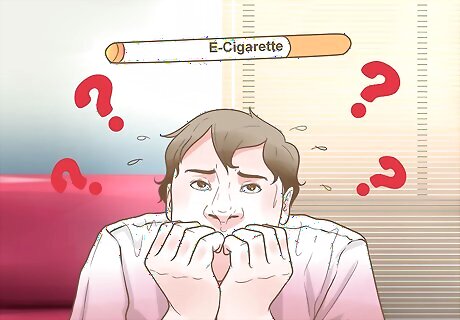
Identify your vaping triggers so that you can avoid them. Certain activities can cause you to crave e-cigarettes after you quit. Make a list of when and where you usually vape. These will likely become your triggers once you quit. If you always vape after waking up, plan a new activity to do in the morning, such as yoga or taking a walk. You might also have an extra cup of coffee in the morning. If you vape in the car while driving, keep gum or hard candy in the car to use instead. You can also try carpooling to work to avoid the urge. If you vape socially at bars or parties, replace these activities with other social activities. For instance, go to the movies with your friend or plan a trip to the local rock climbing center. If boredom makes you vape, get a new hobby. You might learn how to cross-stitch or join a soccer team.

Tell your friends and family in advance that you are going to quit. Explain that you want to stop vaping and that you would appreciate their support throughout the process. Warn them that you may be irritable during the nicotine withdrawal phase. You might say, “I’ve made a decision that I want to stop vaping. It is an expensive and unhealthy habit. I know that I might be grouchy for a few weeks, but it would mean so much to me if you would stick with me and help me quit.” If any of your friends smoke or vape, ask them if they would stop doing it in your presence. For example, you might say, “I’m really trying hard to quit. I know you still like to vape, and that’s OK. I just ask that you avoid doing it around me.” It could also be helpful to ask a close friend who also vapes to quit with you. You can provide support and hold each other accountable.

Inform your doctor that you want to quit vaping. Your doctor can help you develop an effective quitting plan. They may also be able to prescribe a medication that will increase your chances of success during nicotine withdrawal. Nicotine patches and lozenges do not require a prescription, although nasal sprays containing nicotine do. Your doctor may prescribe a medicine containing bupropion hydrochloride, such as Wellbutrin or Zyban. Another common medication is varenicline (sold under the brand name Chantix). These can help you during the withdrawal phase.
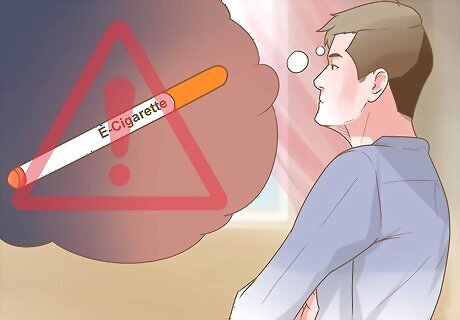
Determine if you want to wean off e-cigarettes or quit cold turkey. There are 2 ways to quit vaping. Weaning involves slowly lowering the amount of nicotine you use until you stop using it entirely. Quitting cold turkey, on the other hand, means that you quit vaping entirely without weaning off nicotine first. The weaning method allows you to quit nicotine first. Once you are through nicotine withdrawal, you can then focus on breaking the routine of vaping. This method will help you manage cravings, although it can take a while. Quitting cold turkey is a cheaper and faster option, although withdrawal is more complicated and intense.
Weaning off E-Cigarettes

Set a schedule for weaning off nicotine. Setting goals for when you want to quit nicotine entirely will help make the process more successful. Create a timeline. Identify when you want to switch to lower levels of nicotine and when you want to quit nicotine entirely. For example, you might lower your nicotine level to 11 mg for 2 weeks and then lower it to 8 mg for another 2 weeks before you start using zero-nicotine liquid. Remember, nicotine withdrawal usually lasts about a month. While it might be less intense if you wean off of it first, make sure that you understand how long it might last.

Reduce the strength of nicotine in your liquid. E-cigarette liquids come in 6 different strengths: 0 mg, 8 mg, 11 mg, 16 mg, 24 mg, and 36 mg. To help wean you off of the nicotine, choose a slightly lower strength than normal. After a few weeks, reduce the strength again. Go down one level at a time. If you vape a 16 mg level, you can first move down to 11 mg and then to 8 mg. Once you have successfully lowered the nicotine down to 8 mg, you may be able to switch to zero-nicotine vape liquid. Despite weaning off nicotine, you may still have some cravings and withdrawals once you stop using nicotine. You can get the different levels of nicotine at any vape shop.
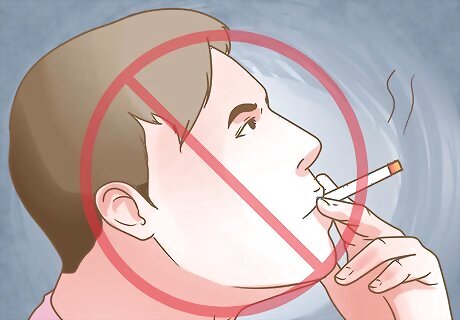
Cut back on how often you vape. Start by eliminating 1 vape session from your daily routine at a time. For example, if you vape 4 times a day, try to cut back first to 3 times a day. After a week or 2, reduce your vaping down to 2 sessions a day. Identify a specific time when you almost always vape and do something else during that time. For example, if you always vape in the car, turn on some music and start singing instead. Be careful not to vape more often when you switch to a lower dose. If you vape more often at a lower dosage, you will not reduce your nicotine intake.
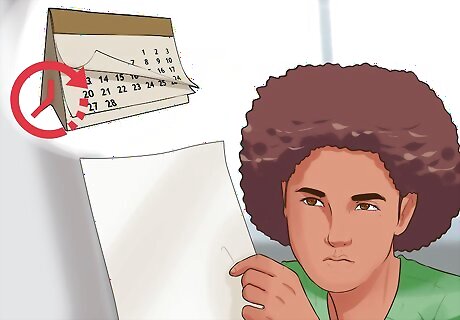
Throw out your e-cigarette. Once nicotine withdrawal has passed, schedule a day to completely quit vaping. The night before, throw out all of your e-cigarettes and supplies, such as tanks, mods, and e-liquids.
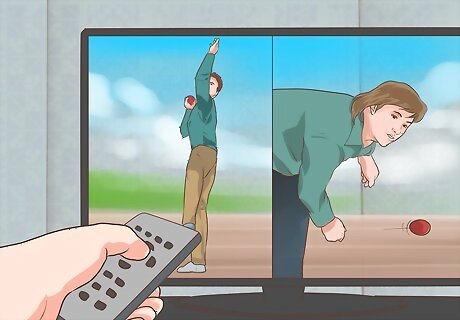
Busy your hands when you want to vape. This will help you break the habit of reaching for an e-cigarette. During times when you normally like to vape, do something else with your hands. For example, if you always vape while watching TV at home, start an activity that uses your hands. You could learn to knit or play a game on your phone. Using a coloring app can be helpful as it requires you to focus on the details and use creativity. If you vape socially, bring a stress ball with you. Squeeze it when you are feeling the craving to vape.
Quitting Cold Turkey
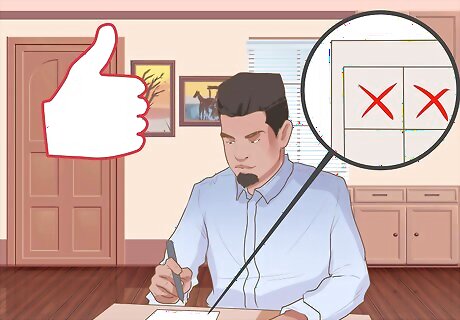
Schedule the day you want to quit vaping. By picking a specific day, you will avoid procrastinating about quitting. It will also give you a little bit of time to prepare for quitting itself. This will increase your chances of success.
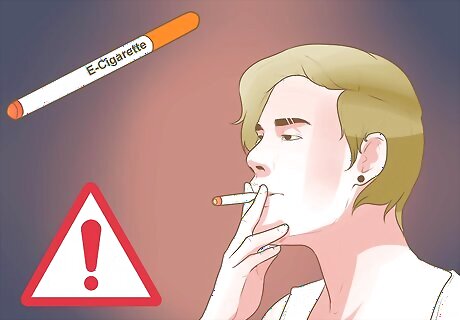
Throw away all of your e-cigarettes. The night before you quit, throw away all of your e-cigarettes and liquids. Take the trash out so that you cannot retrieve these supplies when withdrawal kicks in. You may start feeling cravings as soon as 1 hour after your last e-cigarette.

Keep yourself busy during the withdrawal period. Withdrawal can be more intense for people quitting cold turkey than those weaning off of nicotine slowly. To be prepared for this, plan to keep yourself active and occupied throughout the withdrawal period. Schedule activities for yourself when you usually vape. For example, take a nighttime pottery class instead of sitting at home. It is a good idea to plan more activities than you may have time for, just to avoid any downtime. Incorporate some light exercise into your routine. You might go for a run after work or take a brisk walk when you wake up. If you have some vacation days saved up, go on a retreat to break yourself entirely of the habit. Don’t bring any e-cigarettes with you.
Dealing with Nicotine Withdrawal

Prepare for side effects lasting up to a month. Everyone experiences withdrawal differently. You may have increased appetite, insomnia, strange dreams, chills, anxiety, heartburn, or a number of other effects. In most cases, however, these symptoms only last up to a month. Insomnia usually only lasts for the first week. If you have insomnia after this week, see a doctor. You may feel hungrier than normal for the first 2 weeks. Instead of reaching for sugary or processed snacks, try snacking on vegetables and fruits. Some good snacks include carrots and hummus, celery and peanut butter, or apple slices. As time goes on, cravings will grow farther and farther apart. You may still feel occasional cravings for up to a year after quitting.

Chew gum or hard foods when you get a craving. The act of chewing can distract your brain from the craving. If you don’t like gum, vegetables or fruits—like carrots, apples, or celery—also work well. You can even suck on a piece of hard candy to keep your mouth busy.

Use nicotine gum, lozenges, or patches to help manage cravings. You can get these without a prescription at a drugstore. Over time, you may reduce the dose of nicotine you use until you are free from nicotine entirely. Talk to your doctor to find the best option for you. You can chew gum until your mouth tingles. Stick the gum between your cheek and teeth to absorb the nicotine. Choose a flavor of gum that was similar to your favorite e-liquid flavor to help make the switch more successful. Lozenges are a type of hard candy. Suck on them to slowly dissolve nicotine in your mouth. Patches are placed on the skin. They give a steady amount of nicotine over time.

Give yourself rewards when you reach your goals. Rewards will teach your brain that good things happen when you avoid vaping. Create small rewards for both little victories and big ones. For example, you might eat a small piece of chocolate when you resist a strong craving. You might go see a movie or visit a water park after 1 week of no vaping. Save the money you used to spend on vaping. You can put it towards a vacation or buy yourself something nice.

Get some extra sleep. Nicotine is a stimulant, which means that it makes you feel alert and awake. Without it, you may feel tired or sleepy. Try going to bed earlier in the evening to help prevent this feeling of exhaustion. You may also want to plan daily naps.
Increasing Your Success

Join a support group. Groups like Nicotine Anonymous often meet at community centers, houses of worship, and hospitals. These groups will connect you with others who are struggling to kick their nicotine habit. They can provide advice and support throughout the process of quitting. You can find a local Nicotine Anonymous group by going here: https://nicotine-anonymous.org/find-a-meeting.html There are also online support groups, such as Voices of Nicotine Recovery and In the Rooms.

Call a helpline if you need additional support. These phone lines are free to use. They will connect you to a speaker who can talk you through your cravings and motivate you to continue. Some good services include: National Cancer Institute (US): 877-44U-QUIT (877-448-7848) Smokefree National Helpline (UK): 0300 123 1044 Quitnow (Australia): 13 7848 Smoker’s Helpline (Canada): 877-513-5333

Reduce stress in your life. Quitting vaping may increase irritability or anxiety in your life, both of which can affect your personal relationships and cause new stress. To increase your chances of success, try to eliminate any sources of stress. Try to avoid taking on new responsibilities at work or in your social life until you have successfully quit. Avoid people and situations that make you feel stressed. For example, if you get nervous at large parties, stick to smaller social events until you have quit. Look into relaxation techniques, such as meditation or tai chi. Take some time each day to unwind. You might take a hot bath, get a massage, or read a book.



















Comments
0 comment